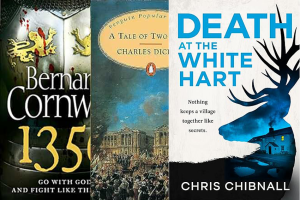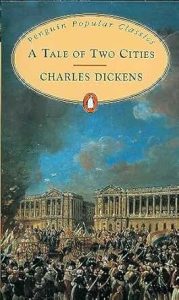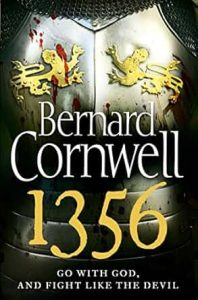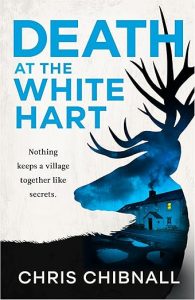
A Tale of Two Cities by Charles Dickens

It would not really be correct to say that Dickens was a historical novelist. True, he was writing largely about the Victorian period and, while it may be history to us, it was the era in which he himself was living.
The only proper exceptions for Dickens are Barnaby Rudge, set at the time of the Gordon Riots in 1780, and the much better known A Tale of Two Cities with its central characters embroiled in the mayhem of the French Revolution.
The two cities of the title are London and Paris and the story centres on the plight of a certain Dr. Alexandre Manette and his daughter Lucie. Manette is imprisoned in The Bastille and family and friends on both sides of the Channel are doing their utmost to extricate him.
Caught up in the action are ne’er do well lawyer Sydney Carton and Charles Darnay, the good guy of the piece, who, unfortunately, although he has renounced his title, has family connections to the hated and now hunted French aristocracy.
In opposition are the villains chiefly Darnay’s relative the Maquis St. Evremond and Madame Defarge. Yes, she’s the one who sits at the front knitting while the guillotine does its grisly work.
Having survived a trial in London, Darnay is captured when he returns to France. Can he clear his name yet again or will he face the ultimate punishment as The Reign of Terror continues to run rampant?
As if that isn’t enough, the novel probably has the best opening and closing lines of any piece of literature ever written. A gem then, all the way through, from “It was the best of times; it was the worst of times.” to “It is a far, far better thing that I do than I have ever done;”
Published by Penguin Classics
1356 by Bernard Cornwell

Before starting this novel, I had no idea what a haubergeon was, why I might be wearing a bascinet and what the difference was between riding a destrier rather than a courser. Now I know the answers I could probably hold my own speaking in Old French if, by any huge stretch of the imagination, I happened to encounter a Norman knight.
Bernard Cornwell is a prolific writer and is probably best known for his series of books on the adventures of Richard Sharpe during the Napoleonic Wars. He has written about other historical periods also and this is one such example.
This riveting tale of derring-do is set during The Hundred Years War when the English throne laid claim to much of France and The Black Prince, otherwise known as Edward of Woodstock or The Prince of Wales, earned a fearsome reputation as a warlord with his ability to deploy the lethal use of the English longbow.
Before there was the Battle of Crecy (1346), later came Agincourt (1415) but this particular yarn climaxes in the Battle of Poitiers, hence the title 1356. Before we get to the denouement though there are plenty of romping escapades with one of the bowmen’s leaders, Sir Thomas of Hookton, involving kidnapped princesses, evil landowners, dodgy clerics and the search for the talismanic ‘La Malice’.
Cornwell’s narrative is highly engrossing and the way he uses the ‘expedition like’ travels around France always keeps the pot boiling. He is certainly one of the best historical authors when it comes to describing the frenzy of medieval warfare and the section on the battle itself is, especially for students of the period, worth a read on its own.
By the way, I also now know why archers usually removed the strings from their bows when not in use and the reason for tying a piece of rag near the top of your pike when fighting hand-to-hand. Answering a ‘call of nature’ wearing full armour? Don’t ask.
Footnote: The Black Prince never did become king. He died at the age of 46, one year before his father, King Edward III, who was succeeded by the Black Prince’s son, Richard II.
Published by Harper-Collins
Death at The White Hart by Chris Chibnall

Chris Chibnall is probably best known for his award-winning series Broadchurch, set in West Bay, and other drama projects but he is the latest celebrity to turn his hand to novel writing.
Adding appeal to this enterprising and very readable debut is that this whodunnit is also set in and around Dorset’s coast, although the author has used a number of fictitious names for locations.
As the title suggests the victim this time is the landlord of the local pub who turns up dead in a deserted country road bizarrely bedecked in a set of deer antlers. An odd killer’s quirk, a ritual slaying, a personal vendetta or is this symbolic—a device to convey to everyone an important message?
Trying to piece all the riddles together are experienced detective Nicola Bridge and her rookie sidekick Harry Ward. Bridge is used to crime in the big city where investigating teams are larger and so has to adapt to a situation where she is very much thrown back to improvising on much reduced resources.
Like all small communities, the fictional town of Fleetcombe has certain inhabitants who are harbouring damaging secrets, the farmer, the delivery driver, the hairdresser and the local unscrupulous entrepreneur. And that’s not to mention little Shannon who seems to witness a lot of key events from her vantage points in the play park and the pub car park.
There are elements of the usual police procedural format about the novel and it does take a while to gather pace. Maybe the latter is because the author feels time needs to be invested in layering characters in some detail as, unlike television dramas, there are no visual images to rely on.
Interest has already been shown in the novel by television companies and it seems likely that production will start possibly later this year or in 2026.
Published by Michael Joseph




